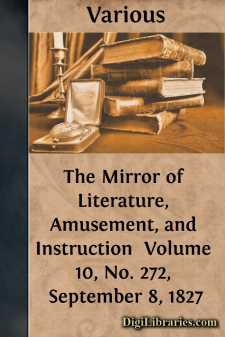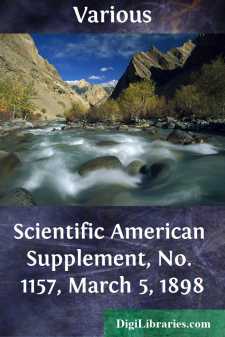Categories
- Antiques & Collectibles 13
- Architecture 36
- Art 48
- Bibles 22
- Biography & Autobiography 813
- Body, Mind & Spirit 142
- Business & Economics 28
- Children's Books 15
- Children's Fiction 12
- Computers 4
- Cooking 94
- Crafts & Hobbies 4
- Drama 346
- Education 46
- Family & Relationships 57
- Fiction 11829
- Games 19
- Gardening 17
- Health & Fitness 34
- History 1377
- House & Home 1
- Humor 147
- Juvenile Fiction 1873
- Juvenile Nonfiction 202
- Language Arts & Disciplines 88
- Law 16
- Literary Collections 686
- Literary Criticism 179
- Mathematics 13
- Medical 41
- Music 40
- Nature 179
- Non-Classifiable 1768
- Performing Arts 7
- Periodicals 1453
- Philosophy 64
- Photography 2
- Poetry 896
- Political Science 203
- Psychology 42
- Reference 154
- Religion 513
- Science 126
- Self-Help 84
- Social Science 81
- Sports & Recreation 34
- Study Aids 3
- Technology & Engineering 59
- Transportation 23
- Travel 463
- True Crime 29
The Mirror of Literature, Amusement, and Instruction Volume 10, No. 272, September 8, 1827
by: Various
Categories:
Description:
Excerpt
DUBLIN POST OFFICE.
The general post-office, Dublin, was at first held in a small building on the site of the Commercial Buildings, and was afterwards removed to a larger house opposite the bank on College Green (since converted into the Royal Arcade;) and on January 6, 1818, the new post-office in Sackville-street was opened for business.
The foundation-stone of this magnificent building, which is built after a design of Francis Johnson, Esq., was laid by his excellency Charles, Earl of Whitworth, August 12, 1814, and the structure was completed in the short space of three years, for the sum of 50,000l.
The front, which extends 220 feet, has a magnificent portico (80 feet wide), of six fluted Ionic columns, 4 feet 6 inches in diameter. The frieze of the entablature is highly enriched, and in the tympanum of the pediment are the royal arms. On the acroteria of the pediment are three statues by John Smyth, viz.—Mercury on the right, with his Caduceus and purse; On the left Fidelity, with her finger on her lip, and a key in her hand; and in the centre Hibernia, resting on her spear, and holding her shield. The entablature, with the exception of the architrave, is continued along the rest of the front; the frieze, however, is not decorated over the portico. A handsome balustrade surmounts the cornice of the building, which is 50 feet from the ground. With the exception of the portico, which is of Portland stone, the whole is of mountain granite. The elevation has three stories, of which the lower or basement is rusticated, and in this respect it resembles the India House of London, where a rusticated basement is introduced, although the portico occupies the entire height of the structure.
Over the centre of the building is seen a cupola, containing the chimes and bell on which the clock-hammer strikes. The bell is so loud, that it is heard in every part of the city.
The interior is particularly remarkable for the convenience of its arrangement, and the number of its communicating apartments. The board-room is a very handsome apartment, furnished with two seats, which are for the postmasters-general. Over the chimney-piece, protected by a curtain of green silk, is a bust of Earl Whitworth, in white marble, by John Smyth.
No. XXIV.HIGH CROSS.
A Roman Station—the Camp of Claudius—Manners, Customs, and Dialects of the people of the District.
About two miles to the west of Little Claybrook, in the hundred of Luthlaxton, in Leicestershire, is a place called High Cross, which, according to some antiquarians, was the Benonce or Vennones of the Romans. Dr. Stukely describes this station as situated at the intersection of the two great Roman roads, "which traverse the kingdom obliquely, and seem to be the centre, as well as the highest ground in England; for from hence rivers run every way. The foss road went on the backside of an inn standing here, and so towards Bath. The ground hereabout is very rich, and much ebulus (a herb much sought after for the cure of dropsies,) grows here....












